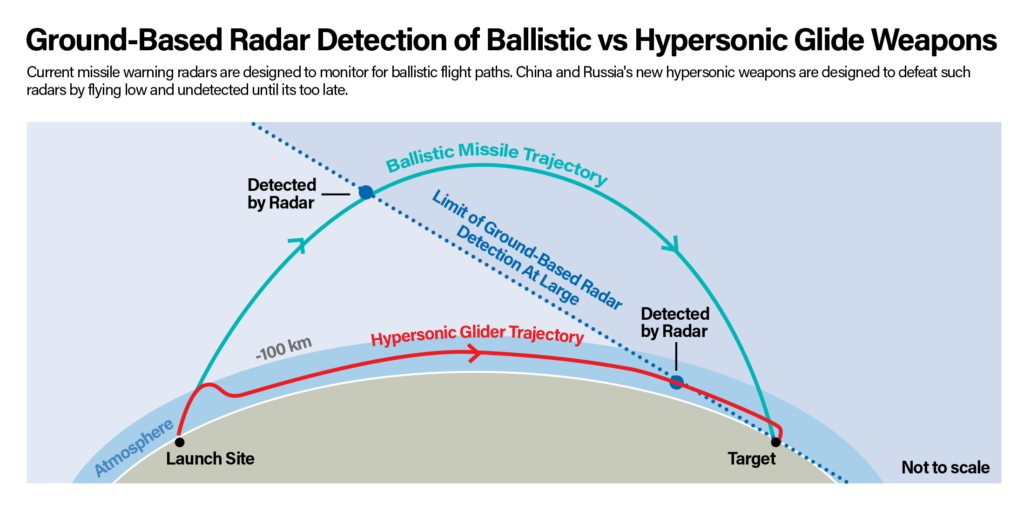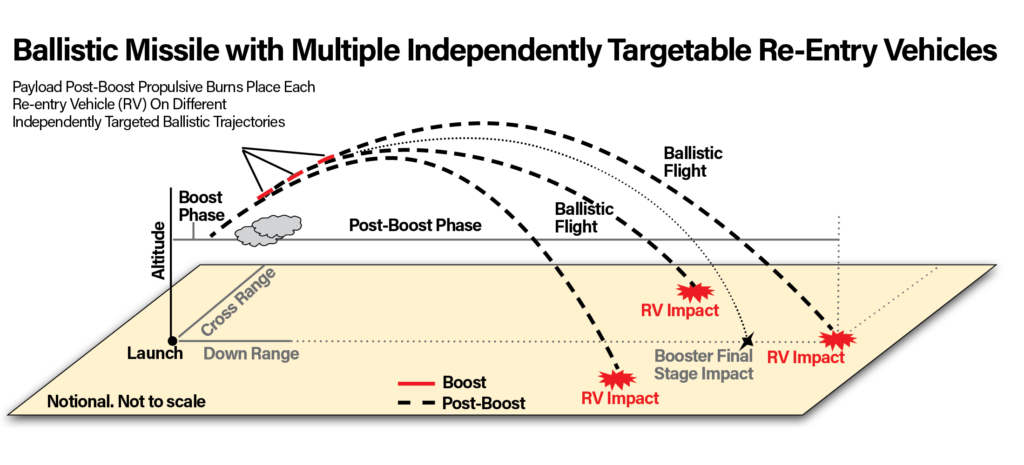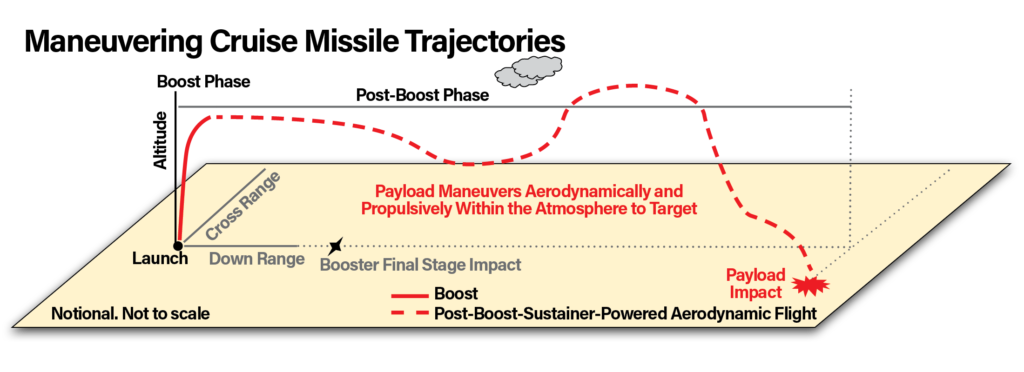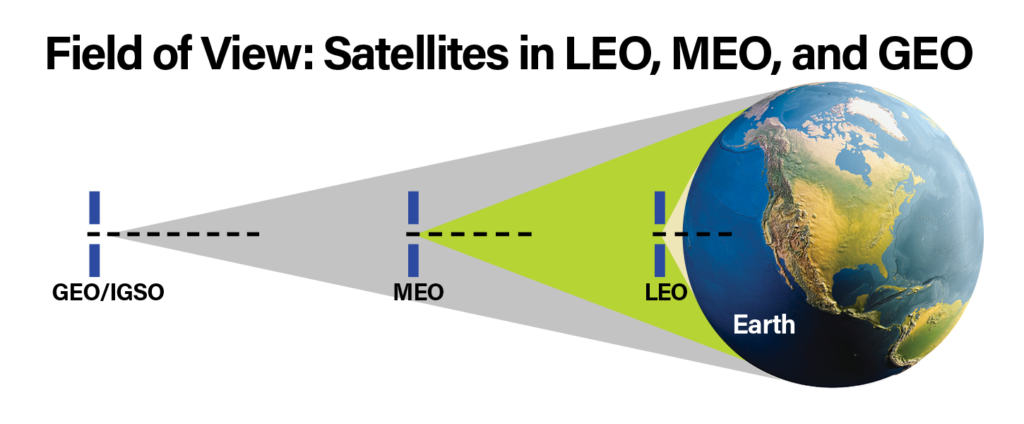America needs a more resilient missile warning system.
America’s Space Based Infrared System (SBIRS) is the most advanced ballistic missile warning capability in the world. Looking forward, however, SBIRS alone will not provide adequate warning of missile attacks by peer adversaries on the United States and its forward deployed military forces. Both China and Russia are fielding a new generation of hypersonic, low-flying missiles that U.S. ground-based radars are unable to track in the time needed to provide warning and cue defenses. They are also fielding anti-satellite (ASAT) weapons to degrade or destroy existing U.S. space-based missile warning sensors. Current U.S. systems lack sufficient defenses against these threats and are locked into predictable orbital regimes that leave them vulnerable. These capabilities, and America’s relative vulnerabilities, give China and Russia a decisive advantage in a major conflict with the United States.
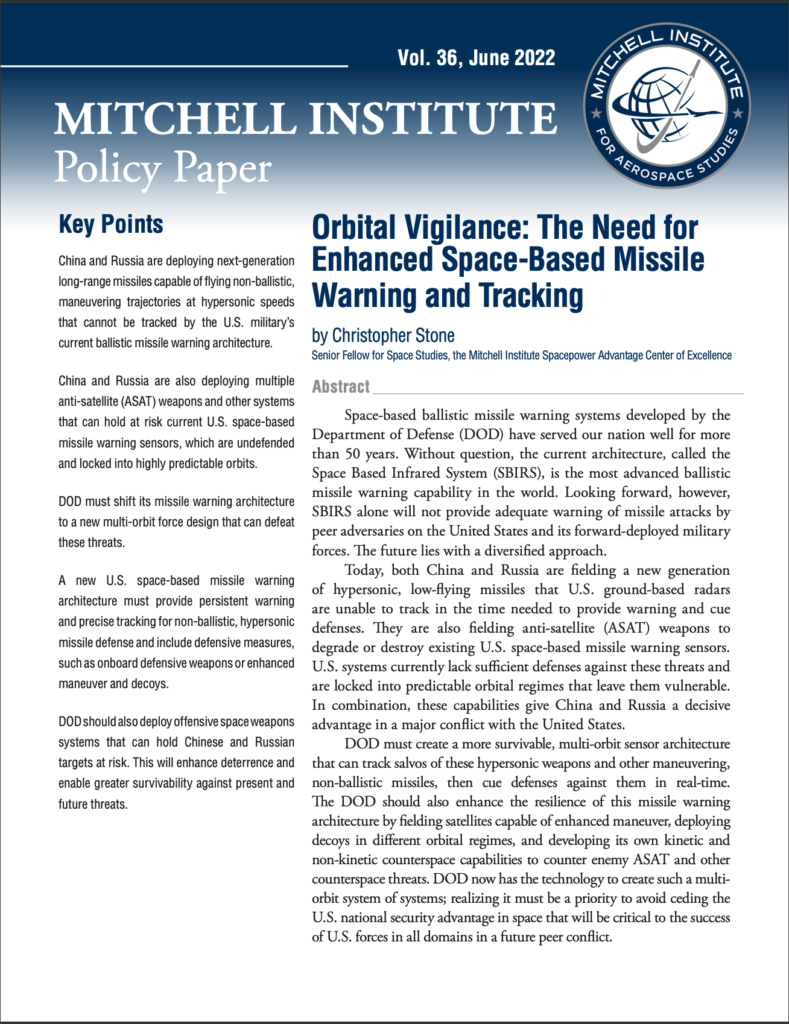
Christopher Stone is senior Fellow for Space Studies at the Mitchell Institute Spacepower Advantage Center of Excellence. Download the entire report here.
In order to defeat large-scale missile attacks, you have to “see” them first, then provide warning in time to cue countermeasures. For that reason, detecting and tracking nuclear strikes on the United States has been a primary requirement for DOD’s space-based missile warning systems since the Soviet Union first developed nuclear-tipped intercontinental ballistic missiles (ICBMs) in the 1950s. At that time, the United States developed a network of space-based infrared (IR) and terrestrial long-range sensors to provide early warning. The first architecture, called the Missile Defense Alarm System (MIDAS), was a 12-satellite constellation designed to provide U.S. leaders with enough advanced notice of a Soviet ICBM attack to direct a response before DOD’s nuclear forces could be destroyed.
A more advanced follow-on system called the Defense Support Program (DSP) operated in various configurations from the 1970s until the early 2000s when it was subsumed into the larger SBIRS program. DSP systems were deployed into GEO orbits with supplementary sensors operating in Highly Elliptical Orbit (HEO) to provide uninterrupted global early warning coverage of ballistic missile strikes. An enemy-launched ballistic missile’s rocket would emit IR energy that entered the opening in the satellite’s IR sunshade, passed through a corrector lens, traveled past the photoelectric cell detector array, reflected off a mirror, and then focused onto the detector array. Fourth generation DSP satellites increased the number of infrared cells each satellite carried from 2,000 to 6,000, which further enhanced their ability to discriminate between separate launch events.
As ballistic missile technologies began to proliferate globally during the latter part of the Cold War, DOD adapted its missile warning systems to detect and track shorter-range “theater” ballistic missiles, as well. This development followed DSP successfully detecting several Iraqi short-range SCUD theater ballistic missile launches during the 1991 Gulf War. DOD developed SBIRS to detect shorter-range, non-maneuvering ballistic missile launches and increase the accuracy of the missiles’ predicted impact points. By the mid-1990s, the U.S. space-based missile warning architecture had expanded from nuclear deterrence and defense to also providing warning of theater ballistic missile attacks.
SBIRS, consists of five dedicated satellites operating in geosynchronous Earth orbit and sensors carried by two host satellites in highly elliptical orbit. A SBIRS GEO spacecraft consists of a bus with a radiation-hardened shell and five separate mission downlinks that enhance their survivability and endurability. SBIRS remains an important capability, as the theater ballistic missile threat has only grown. In fact, even with SBIRS, the massive January 2020 Iranian strike into northern Iraq still sent U.S. troops in the area “rushing for shelter.”
SBIRS satellites in GEO and HEO can scan the entire surface of the Earth to detect the IR signatures of missiles in their boost phase of flight after launch—except over the Antarctic region. Unlike previous architectures, SBIRS can continuously scan and provide early warning while simultaneously dwelling over theater areas of interest. However, SBIRS was never designed to continuously track ballistic, non-ballistic, maneuvering, and very-low-altitude hypersonic warheads after separation from their launch boosters. While GEO and HEO are great for achieving global sensor coverage, they are not ideal for systems that must also provide continuous, hi-fidelity tracking of low-flying, maneuverable warheads, which do not produce as intense of an IR signature as their launching booster.
Missile Tracking Challenges
The current U.S. space-based missile warning architecture was optimized to detect traditional ballistic missile launches that followed relatively predictable flight paths and could be detected and tracked early enough to cue defensive systems. Both China and Russia recognized the limitations of these warning systems and deliberately developed long-range missiles to evade detection by SBIRS and other warning sensors.
These new weapons range from low-flying supersonic cruise missiles to Mach 5-plus hypersonic missiles that fly depressed trajectories in the atmosphere and maneuver.
Hypersonic weapons can be launched from airborne aircraft, ships at sea, and land-based mobile launchers. Long-range air-launched hypersonic missiles with scramjet engines could also be launched by an enemy’s bombers from under the cover of air defenses in their own airspace. Such weapons could be deployed as part of a fractional orbital bombardment system. The variety of launch options means hypersonic weapons might not create an IR signature intense enough to be detected by current U.S. sensors.
Long-range ballistic missiles typically have flight trajectories that take them over 300 km into space before they reenter the atmosphere. The highly predictable flight paths and high altitudes of non-maneuvering ballistic missiles make them much easier to detect and track. In contrast, hypersonic missiles can fly as little as 30 to 50 km above the Earth’s surface or even lower, which means that, because of the curvature of the earth, they may be below areas that are effectively covered by today’s radar warning architecture.
Cruise missiles also have low IR signatures that cannot be detected by current overhead systems. Moreover, both cruise missiles and hypersonic weapons can maneuver to create unpredictable flight paths. Very-low-flying weapons can also “hide” in the curvature of the Earth to avoid detection by surface radars. A combination of low-altitude flight and high speeds limits the time available to detect incoming missile threats, predict their impact points, cue defensive systems, and launch countermeasures. Today, most of China’s and Russia’s deployed long-range missiles can carry one or more weapons that can maneuver in space, in the atmosphere, or both.
There are now five basic categories of threats a future U.S. missile warning architecture must be capable of tracking:
1. Traditional long-range ballistic missiles with no post-boost payload maneuverability.
2. Missiles on ballistic trajectories with the ability to perform very small, exo-atmospheric trajectory corrections via multiple large propulsive burns that deploy multiple independently targetable (MIRV) warheads on independent trajectories with impact points several kilometers apart.
3. Missile systems with post-boost weapons, flying ballistic trajectories capable of very small maneuvers during the terminal portions of the trajectory inside the atmosphere, known as maneuvering re-entry vehicles (MaRVs).
4. Boost-glide missiles that fly non-ballistic, depressed trajectories at hypersonic speeds in the upper atmosphere that can maneuver enroute to their target and in the terminal phase.
5. Missiles that can sustain long-range flight in the atmosphere and maneuver after launch, such as cruise missiles.
- Ballistic missiles with limited exo-atmospheric post-boost weapons maneuverability. One type of maneuvering weapon has payload-carrying vehicles equipped with post-boost propulsion system engines that can deploy multiple warheads on independent trajectories while above the atmosphere. ICBMs with Multiple Independently Targetable Re-Entry Vehicles (MIRVs) are one example of this type of weapon. A MIRV ballistic missile carries multiple reentry vehicles on top of its main rocket booster. Some of these reentry vehicles could be configured as unarmed decoys to complicate an opponent’s missile defense operations. Discriminating between “live” weaponized reentry vehicles and decoys can be a major challenge.
- Missiles with warheads capable of minor post-boost, aerodynamic maneuvers in the atmosphere. These weapons are another type of maneuvering threat with external control surfaces that can be moved to direct a warhead to its target with greater accuracy than weapons that can only fly gravity assisted, spin stabilized ballistic flight paths. Maneuverable Reentry Vehicles (MaRVs) are aerodynamically capable weapons that can alter their flight paths within the atmosphere to establish glide profiles that can extend their range. Hypersonic Boost-Glide Vehicles (HGVs) can also aerodynamically maneuver, but they have the capability to glide at hypersonic speeds for most of their flight in the atmosphere after booster separation.
- Missile systems that combine both post-boost propulsion and aerodynamic surfaces. These attributes further extend the range and maneuverability of a warhead’s flight to its target. Examples include the medium-range DF-21D “carrier killer” anti-ship missile, which China has operationally deployed since 2010. The DF-21D has a ballistic missile booster with a payload that separates and maneuvers to a designated target. The missile system has a dual anti-ship and land-attack role; its design includes a post-boost propulsion system and flight surfaces that give its warhead the ability to change targets or modify its flight path to correct for moving targets—like ships at sea.
- Cruise missiles. Finally, cruise missiles are weapons that combine aerodynamic control surfaces and jet propulsion engines to extend their ranges or atmospheric flight times. Cruise missiles can be highly maneuverable, which can increase the number of directions from which a cruise missile can attack a target.
Anti-Satellite Threats
Both China and Russia now consider U.S. space-based assets as high-value targets that can be threatened to coerce the United States in a crisis or attacked to achieve space superiority in a conflict. They have developed kinetic ASATs and other space weapons to hold these “difficult to defend, easy to attack” targets at risk. These capabilities could give China and Russia the means to negate much of DOD’s current ability to detect large-scale missile attacks, track them, and relay fire control information to U.S. air and missile defenses. This could give China or Russia a decisive advantage in a major conflict with the United States. These realities point to the need to ensure that DOD’s future missile warning architecture and other space systems are designed and deployed in modes that will help them survive and operate in this contested environment.
China has developed and deployed what it refers to as a “multi-layered attack architecture” with weapons systems that span the counterspace threat continuum. Used in combination, these weapons can degrade, deny, or destroy U.S. space systems in all orbital regimes.
On the non-kinetic side of this threat continuum, China has operational ground-based jamming systems that are capable of disrupting satellite communications, GPS navigation signals, synthetic aperture radars, missile warning, and other satellite systems. Jamming can prevent users from using satellite communication networks, degrade or prevent transmissions of vital missile warning data from space-based sensors to warfighters, and disrupt uplinks and downlinks needed to command and control spacecraft.
On the kinetic side of the threat continuum, Chinese forces have deployed ground-launched ASAT missiles that can attack assets in LEO. China has also demonstrated capabilities to reach targets in MEO and GEO, as well as its ability to maneuver co-orbital anti-satellite spacecraft close to high-value U.S. space systems.
Like China, Russia views space as a warfighting domain, and they base their warfighting doctrine around the idea that achieving space supremacy is a precondition for winning a conflict with the United States. Consistent with these beliefs, Russia has committed to developing space capabilities to deter the United States and its allies and to attack their space assets in the event of war.
Russia has fielded a suite of non-kinetic options to create reversible effects on satellite systems in space, including ground-based systems to counter GPS navigation signals, tactical communications, satellite communications, and radars. Reportedly, Russia is also developing an airborne laser platform to use against space-based missile warning sensors. Perhaps most importantly, Russia has demonstrated several ASAT missiles that could become operational within the next few years that can destroy targets in LEO. In late 2021, Russia demonstrated this capability in a live-fire, hit-to-kill demonstration. The Russian government also appeared unfazed by orbital debris created by this demonstration, emphasizing instead that it had gained another means of threatening adversaries’ space systems in a crisis.
Diversified Space-Based Tracking
There is an answer to these challenges. DOD now has the technology to create a multi-orbit system of systems that can detect non-ballistic missiles from launch to their designated target areas. The most effective approach would be to develop a multi-layered, space-based architecture of sensors across all orbital regimes—low Earth orbits (LEO), medium Earth orbits (MEO), geosynchronous Earth orbits (GEO), and Polar orbits. This multi-orbit architecture must be capable of detecting missile launches, tracking maneuvering missiles at all altitudes, and then providing fire control information directly to air and missile defenses in near-real-time. DOD should enhance resilience by fielding satellites capable of enhanced maneuver to avoid or otherwise negate ASATs; Deploying decoys at LEO, MEO, and GEO to complicate an adversary’s attack; and developing its own kinetic and non-kinetic counterspace capabilities to directly defeat enemy ASAT and other counterspace threats. In fact, this is the direction the Space Force is already moving in, as General Jay Raymond has explained: “We are diversifying the architecture to reduce the threat in space to an attack that may occur. We pivot from handfuls of very exquisite, very expensive satellites, to an architecture that’s more diversified to get after both the emerging class of missiles and the threat that currently exists in space.”
Proliferated-LEO Tracking Layer
The Space Development Agency’s (SDA) National Defense Space Architecture Tracking Layer now in development is intended to increase DOD’s ability to receive timely warning of attacks by hypersonic weapons and other emerging missile threats. SDA’s design evolves over time. Tranche 1 will initially consist of 28 tracking vehicles with IR sensors to detect and track missiles; over 100 transport layer vehicles to “provide assured, resilient, low-latency military data and connectivity worldwide to the full range of warfighter platforms”; and other orbiting satellites. These Tranche 1 vehicles will orbit at an altitude of approximately 1,000 km above the Earth—in Low Earth Orbit—with an inclination between 80 and 100 degrees. One advantage of a proliferated LEO constellation force design is the added operational resilience that its hundreds of satellites create. Over time, SDA will “expand its global coverage and chain of custody of various missile threats.”
An important SDA goal is to fully integrate information from its Tracking Layer with other space-based missile warning capabilities to provide highly accurate fire control solutions for both current and future missile defense operations. This will be the mission of battle management, command, control, and communications (BMC3) modules in each Tracking Layer satellite. These modules will be designed to support key mission functions such as processing data from sensors, fusing data from multiple satellites in the constellation into three-dimensional missile tracks, and managing operational tasks.
Proliferated LEO constellations will increase the resiliency of DOD’s future missile warning operations, but will not be enough on their own to offset growing counterspace threats. They remain vulnerable to non-kinetic threats including radio frequency (RF) jamming and high power microwave (HPM) weapons that could affect multiple systems in LEO in very short periods of time.
RF jamming includes ground-based systems capable of using RF frequencies to block or damage communications links be-tween satellites in LEO and their user ground stations. Downlink jamming can enhance the “noise” of a satellite signal to the extent that the signals are not useful or cannot be received by ground users. Uplink jamming can likewise block or otherwise interfere with signals going up to the satellite from major operational commands or ground sites that provide command and control over the vehicle. Targets of these jamming systems are typically high-value GEO satellites or SATCOM systems.
HPM weapons are another emerging threat to assets operating in LEO. Emitters that could be ground-based or mounted on ships, aircraft, or even other satellites could generate pulses of HPM energy that can “disrupt a satellite’s electronics or cause permanent damage to electrical circuits and processors in a satellite.” The “kill” mechanism of counter-electronics HPM weapons is to create a buildup of energy in a vulnerable circuit or electronic component in a satellite past its tolerance levels, causing them to stop working or even burn out.
Given growth in these counterspace threats, global missile warning coverage should include systems based in MEO and GEO.
Medium Earth Orbit Basing Concept
MEO orbits—in the space between 2,000 km and 35,766 km (the edge of GEO) above the Earth—have been called the “sweet spot” for satellite systems.
Satellites in MEO are closer to the Earth than GEO-based DSP and SBIRS satellites, which reduces the time needed to transmit missile warning information signals to air and missile defenses. MEO sensors provide faster and higher fidelity missile warning information transmission compared to sensors operating in more distant GEO.
Conversely, compared to LEO, sensors orbiting in MEO have longer pass times over target areas and wider fields of view, so they can maintain custody of missile tracks for longer. It would require between 9 and 36 missile warning satellites in MEO to achieve continuous global coverage, compared to the hundreds of satellites needed to achieve the same coverage for a LEO constellation.
MEO-based systems are vulnerable, however, to numerous counterspace threats.Adversaries have demonstrated MEO-capable ASAT systems since 2014. Chinese and Russian co-orbital ASATs and counterspace systems capable of operating across multiple orbits to attack targets are clear threats to satellites in MEO. A resilient, survivable space-based missile warning and tracking force design with onboard defensive capabilities such as maneuver, decoys, or active defense weapons should be based across all orbital regimes and hardened against the threats that will exist in the “rapid and destructive” dynamic space warfighting environment China and Russia seek to create.
Geosynchronous Earth Orbit Basing
GEO-based satellites have the advantage of providing “persistent stare” coverage for boost-phase ballistic missile warnings while monitoring specific theaters for shorter-range theater ballistic missile events simultaneously.
DOD’s objective is to create multiple fields of view over designated regions or specific target areas without the need to deploy massive constellations into GEO. Next Generation OPIR sensors will be three times as sensitive and two times more accurate than SBIRS sensors to better detect and track the weaker IR signatures of non-ballistic missiles such as hypersonic weapons. Next Generation OPIR will also have a downlink data rate four times greater than SBIRS.
Data collected by Next Generation OPIR during the initial phase of a missile attack could cue sensors in other layers. Satellites deployed at MEO could use these cues to begin tracking threats as they transition to their post-boost and mid-course phases of flight. The lower altitudes of IR sensors in MEO will help increase the fidelity of missile tracks in preparation for handing off threats to LEO layer sensors. Finally, a mature future proliferated LEO constellation with its hundreds of satellites will provide even higher fidelity tracks that give air and missile defenses on the ground, in the air, and at sea the information they need to achieve precise fire control solutions.
Conclusion and Recommendations
- DOD has the technology to develop a new space-based missile warning and tracking architecture that is capable against emerging threats. Countermeasures are also needed. DOD and the U.S. Space Force should consider active and passive capabilities that would help deter attacks on the force design and counter them should deterrence fail.
- DOD should adopt a multi-layered satellite architecture that combines legacy ballistic missile warning capabilities with enhanced sensors in LEO, MEO, GEO, and Polar orbits to detect and track hypersonic weapons and other novel missile threats over their entire flight profiles. Multiple, complimentary layers of sensors should be a threshold requirement for any future missile warning and tracking architecture that is designed to operate and survive in future contested space environments.
- DOD should develop the capability to deploy decoy satellites in LEO and MEO orbital regimes to complicate Chinese and Russian counterspace targeting operations. This defensive measure would enhance deterrence as well as increase the resiliency of DOD’s space-based missile warning architecture in a conflict. Like late Cold War ICBMs that carried decoy reentry vehicles to complicate an enemy’s missile defense operations, mixing decoys with active missile warning and tracking satellites across all orbital regimes, but especially MEO and GEO, will pose a targeting dilemma for China and Russia. It could possibly even cause them to waste high-value ASAT assets on non-operational, low-cost decoys.
- DOD should take advantage of mature technologies that will increase the maneuverability of satellites in MEO and GEO. Given the limited numbers of satellites deployed to MEO and GEO, increasing their survivability by giving them the ability to rapidly maneuver to avoid threats and fill gaps in a post-attack environment will be vital. Missile warning and tracking satellites in MEO and GEO basing layers should transition from using limited lifespan, chemically based propellants to other more advanced propulsion capabilities to enhance their ability to maneuver to avoid attacks and change orbits post attack.
- Both Chinese and Russian strategic space writings indicate their militaries believe an effective deterrent in space must include capabilities that can attack an adversary’s space infrastructure in a “rapid and destructive” manner. DOD should likewise rapidly and overtly field kinetic and non-kinetic ASAT systems in sufficient numbers to hold adversary space systems at risk to enhance deterrence and, in the event deterrence fails, achieve victory. These capabilities would not only deter peer adversary attacks on U.S. space-based missile warning and tracking assets, but they would also increase options to respond to attacks in space.

